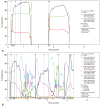Change of distribution and timing of bite force after botulinum toxin type A injection evaluated by a computerized occlusion analysis system
- PMID: 24954346
- PMCID: PMC4075376
- DOI: 10.3349/ymj.2014.55.4.1123
Change of distribution and timing of bite force after botulinum toxin type A injection evaluated by a computerized occlusion analysis system
Abstract
Purpose: The aim of this study was to determine the force distribution and pattern of mastication after injection of botulinum toxin type A (BTX-A) into both masseter muscles. The hypothesis to be tested was that the difference between right and left balance of occlusal force diminishes over time following BTX-A injection.
Materials and methods: Fifteen patients were submitted to BTX-A injection therapy for subjective masseter hypertrophy. A total of 25 U of BTX-A (50 U in total) was injected into two points located 1 cm apart at the center of the lower one-third of both masseter muscles. All patients were examined using the T-Scan occlusion analysis system before and 4, 8, 12, and 24 weeks after BTX-A injection.
Results: A significant change in force balance was found between the right and left sides over time and the difference between the two sides decreased with the time post-injection, reaching a minimum at 12 weeks. Comparison of the force balance between the anterior and posterior occlusions revealed no significant difference at any of the time points. The occlusion and disclusion times (right and left sides) did not differ significantly with time since BTX-A injection.
Conclusion: A decline in the difference in the clenching force between the left and right sides was found with increasing time up to 12 weeks following BTX-A injection.
Keywords: Botulinum toxin type A; bite force; dental occlusion; masseter muscle; mastication; time factors.
Conflict of interest statement
The authors have no financial conflicts of interest.
Figures




Similar articles
-
The change of maximum bite force after botulinum toxin type a injection for treating masseteric hypertrophy.Plast Reconstr Surg. 2007 Nov;120(6):1662-1666. doi: 10.1097/01.prs.0000282309.94147.22. Plast Reconstr Surg. 2007. PMID: 18040203
-
Muscle weakness after repeated injection of botulinum toxin type A evaluated according to bite force measurement of human masseter muscle.Dermatol Surg. 2009 Dec;35(12):1902-6. doi: 10.1111/j.1524-4725.2009.01319.x. Dermatol Surg. 2009. PMID: 19737290
-
Changes in masticatory function after injection of botulinum toxin type A to masticatory muscles.J Oral Rehabil. 2013 Dec;40(12):916-22. doi: 10.1111/joor.12111. Epub 2013 Nov 8. J Oral Rehabil. 2013. PMID: 24237358
-
Assessment of changes in masseter muscle by three-dimensional close-range photogrammetry after Botulinum toxin type-A injection: A case report with review of literature.J Pak Med Assoc. 2019 Mar;69(3):418-422. J Pak Med Assoc. 2019. PMID: 30890839 Review.
-
Botulinum Toxin Injections for Masseter Reduction in East Asians.Dermatol Surg. 2019 Apr;45(4):566-572. doi: 10.1097/DSS.0000000000001859. Dermatol Surg. 2019. PMID: 30883483 Review.
Cited by
-
Intramuscular Neural Distribution of the Serratus Anterior Muscle: Regarding Botulinum Neurotoxin Injection for Treating Myofascial Pain Syndrome.Toxins (Basel). 2022 Apr 11;14(4):271. doi: 10.3390/toxins14040271. Toxins (Basel). 2022. PMID: 35448880 Free PMC article.
-
Botulinum toxin type A injection into the masticatory muscles and its effects on mandibular bone resorption and density. A systematic review.Clin Oral Investig. 2024 Aug 9;28(9):477. doi: 10.1007/s00784-024-05838-5. Clin Oral Investig. 2024. PMID: 39123075
-
An Ultrasonographic Analysis of the Deep Inferior Tendon in the Masseter Muscle: Implications for Botulinum Toxin Injections.Toxins (Basel). 2024 Sep 11;16(9):391. doi: 10.3390/toxins16090391. Toxins (Basel). 2024. PMID: 39330849 Free PMC article.
-
Occlusal Analysis in Natural Dentition: Systematic Review.Eur J Dent. 2023 Jul;17(3):615-622. doi: 10.1055/s-0042-1755626. Epub 2022 Oct 17. Eur J Dent. 2023. PMID: 36252609 Free PMC article.
References
-
- Clark GT. The management of oromandibular motor disorders and facial spasms with injections of botulinum toxin. Phys Med Rehabil Clin N Am. 2003;14:727–748. - PubMed
-
- Freund B, Schwartz M, Symington JM. Botulinum toxin: new treatment for temporomandibular disorders. Br J Oral Maxillofac Surg. 2000;38:466–471. - PubMed
-
- Lang AM. Botulinum toxin therapy for myofascial pain disorders. Curr Pain Headache Rep. 2002;6:355–360. - PubMed
-
- Lovell BV, Marmura MJ. New therapeutic developments in chronic migraine. Curr Opin Neurol. 2010;23:254–258. - PubMed
-
- Bhogal PS, Hutton A, Monaghan A. A review of the current uses of Botox for dentally-related procedures. Dent Update. 2006;33:165–168. - PubMed
Publication types
MeSH terms
Substances
Supplementary concepts
LinkOut - more resources
Full Text Sources
Other Literature Sources
Medical

